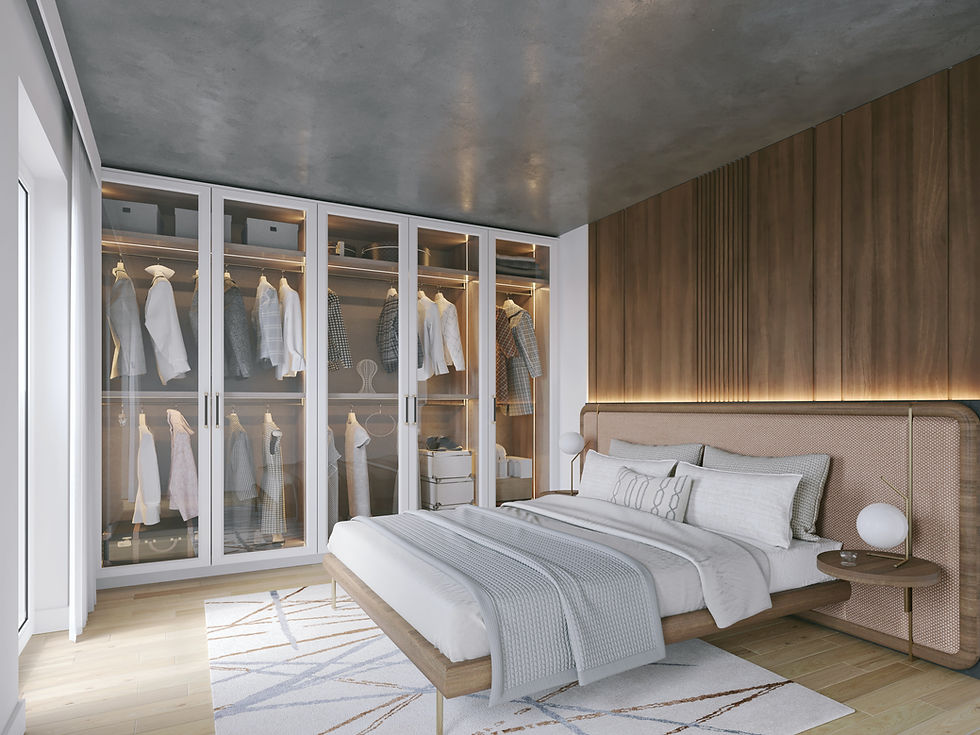All You Need to Know about Wardrobe Materials & Finishes
- kaurkaramdeep36
- Feb 22, 2021
- 3 min read
Updated: Oct 25, 2022
Wardrobes are made of a number of materials and finishes. You should be aware of all these before you purchase or customize wardrobes; because these finishes and materials impact the cost as well as durability.
Materials
1. MDF (Medium-Density Fiberboard) -
Crockery shelves, bedroom, and living room pieces are made primarily of MDF. MDF is a manufactured board that, like Ply, is formed by converting leftover hardwood or softwood wood into wood fibers. MDF is a cheap and environmentally friendly solution because of this. The material is denser and stronger than particle board. It is less durable than plywood and shouldn't be used in sink boxes in kitchens or bathrooms because it retains moisture.
2. Plywood
Plywood is created and manufactured by gluing thin "plies" of wood veneers together. Most kitchen cabinets and wardrobe boxes are made of plywood. Plywood is a framing material that is veneered or laminated on the exterior. In low-moisture locations like living rooms, furniture made of particular commercial ply kinds is used.
3. HDF (High-Density Fiberboard) -
HDF boards are made with the same process as that MDF. But HDF boards are denser and stronger than MDF. Screw holding capacity is also more of these boards than MDF.
4. Particleboard -
Particle board, also known as chipboard or low-density fiberboard, is an engineered wood product manufactured from wood chips and a synthetic resin or another suitable binder, which is pressed and extruded.
5. Solid Wood -
The most appealing material is solid wood. Solid wood goes well with practically any design theme since it reflects a very energizing refreshing luster. Although solid wood is more expensive than other options and does need to be polished on a regular basis, it is often worthwhile because it gives a space a really warm feel and is highly durable. There are different types of solid wood like Ash, Beech, Cherry, Maple, Oak, Pine, walnut, etc.
6. WPC (Wood Plastic Composite) -
Wood fiber/wood flour and thermoplastics are used to make WPC. WPC is pre-laminated and can be used for kitchen furniture, flooring, and walls. This is due to WPC's water resistance and low maintenance requirements. It is an environmentally friendly substance and susceptible to very slow breakdown.
Finishes
1. Laminate
Laminates are simply an attractive buy as veneers because of their affordability, toughness, and water resistance. Users can choose from a variety of laminates that come in a wide range of designs, colors, and finishes, from high-gloss, and textured, to matte.
While laminates are simple to maintain and clean, the sheets of laminate are also quite brittle. They perform poorly over time because of their tendency to scratches since even a small amount of chipping would require replacing the whole sheet.

2. Veneer
One of the most common options for wardrobe treatments is veneer. Veneers are the go-to for an attractive and warm appearance and are made of thin timber sheets. This material offers so many reasonably priced design options that they may accommodate any theme.
In a Scandinavian-style home, for instance, a light veneer will help the wardrobe blend in, whilst a darker tone of the same will work in a classic home. Periodic polishing is necessary for veneer treatments. In addition, veneers can be a highly convenient option for installation and upkeep.

3. Lacquer or polyurethane paint
Polyurethane can be applied to the surface of wood, metal, and plastic. This offers excellent UV resistance and high gloss to the wardrobes.

4. Mirror
From an aesthetic standpoint, mirror is a highly recommended material that can be utilized to cover cabinet shutters. They not only give the room drama, but they also reflect light, giving the impression that the area is larger than it actually is.

5. Glass

Glass as a coating for closets is a fantastic idea with a pretty contemporary twist that may instantly give your space a very distinctive look. The glass's framework, style, and size can be changed to match the interior design of the space.
Because there are so many different types of glass, including opaque, printed, frosted, and stained glass, glass cabinet shutters may not always look the same. They provide many opportunities for experimentation.
6. Metal
Metal finishes are applied on iron and steel wardrobes to provide aesthetics, reduce surface roughness and increase durability. Metal finishes are provided by plating, brushing, polishing, grinding, heat-treating and blasting etc.

7. Fabric

Sometimes designers use foam and fabric on wardrobes when they design rooms or spaces for small kids to make these safer. Except this, the fabric can be sandwiched in two mirrors, for wardrobe doors; the results are totally exhilarating.
Comments